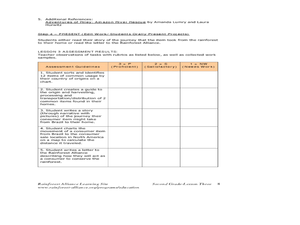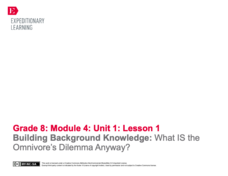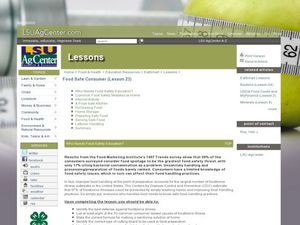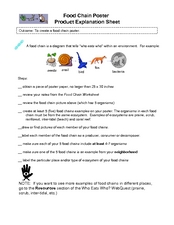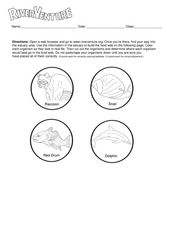Curated OER
Seepy Sandwich
Students explore Earth science by participating in a pollution activity. In this water infiltration lesson plan, students utilize a water sprayer, food coloring and slices of bread to simulate how pollution can spread into our drinking...
Curated OER
Products from the Rainforest
Second graders write a story about the journey a food has from the rainforest to your table. In this food lesson plan, 2nd graders research different foods and products that come from the rainforest and discover how it ended up in their...
Bridge
Mercury - Mercury is Rising
Hold a discussion in your class about the increase in mercury being found in fish that are caught commercially as food for humans. Given a worksheet, learners then calculate how much fish a person can safely eat each month to remain...
Curated OER
Peek at the Chesapeake!
Students research organisms that live in the Chesapeake Bay ecosystem. In this science lesson, students choose an organism and research how it is affected by humans. Students create a presentation of their findings.
Curated OER
Honduras Finding the Top Bananas
Eighth graders complete an online scavenger hunt about banana cultivation before they visit a grocery store to examine banana products. They investigate "certified" means in relation to banana production and read the "Rainforest Alliance...
Curated OER
Harvest!
A visually entertaining PowerPoint on farming is here for you. Specifically, the presentation takes you and your pupils through the harvest of corn and soybeans. All of the machinery used in harvesting, storing, and sending the products...
Curated OER
A Serving By Any Other Name
Students examine the information given on food labels. They also discover what a serving size is and determine how much they eat over the suggested serving. They also calculate the number of calories are in different foods.
Curated OER
Bugs in the Woods
Second graders identify insects and plants in the forest ecosystem in a structured field trip with stations and activity booklets. In this bugs instructional activity, 2nd graders explore the ecosystem of the forest, complete the...
Curated OER
Providing Safe Food to the Consumer
Students identify safe practices that must be followed to assure the food chain from the farm or ranch to dinner table is providing safe and quality food for the consumer. Students visit websites to examine numbers of food borne...
Curated OER
The Barn Owl Pellet
Seventh graders examine the factors that affect the number and types of organisms that an ecosystem can support. In this ecosystem lesson students study the barn owl and where it is on the food chain, then dissect an owl pellet.
Curated OER
Plankton
Learners explore how to collect plankton and use microscopes to observe and identify it. They collect the plankton sample and classify the various components of the plankton. Students identify organisms in the plankton and draw...
EngageNY
Building Background Knowledge: What IS the Omnivore’s Dilemma Anyway?
What's the best thing on the menu? Scholars enter the room, complete a gallery walk of menus to choose a food to pretend to order, and then discuss how they made the decision. Next, they read The Omnivore's Dilemma and relate their...
Curated OER
Food Safe Consumer
Young scholars explain how to prepare and keep food safely. In this health science lesson, students research common mistakes and tips for maintaining a clean kitchen. They identify main causes of foodborne diseases.
Curated OER
Food Chain Poster Instructions
In this food chain worksheet, students follow a set of 9 steps to create a food chain poster. Page has no additional activities.
Curated OER
Who Is Eating Whom?
Students discuss the food chain and identify if various organisms are producers or consumers. They draw ten types of organisms and construct a food web of these organisms, labelling each as a producer or consumer.
Curated OER
River Venture
In this food web worksheet, students color 4 animals and put them in the correct spot on a food web. They answer 3 related short answer questions.
Curated OER
Transforming Food Energy: A Balancing Act
Students explain their role as consumers. They use a purchased calorimeter or make their own simple calorimeter to measure the energy content in selected foods. This interesting activity really gets students thinking about what they eat.
Curated OER
How do pollutants bioaccumulate and biomagnify?
Young scholars review the basic concepts of the food chain. In small groups, they research an organism and create a food web. In addition, they study biomagnifications and write a brief essay or make a poster informing others about the...
Curated OER
Label Language
Fourth graders explore food labels. In this consumer education instructional activity, 4th graders describe and evaluate various components of familiar food labels. Students discuss which traits make a product appealing to consumers....
Curated OER
Animal Relationships
Students study energy pyramids, food chains and food webs. In this animal relationships lesson students complete several activities and play a game.
Curated OER
A Feast for the Future
Students participate in an activity that uses a simulated meal of transgenic foods in order to initiate a discussion of the controversy concerning the use of transgenic food products.
Curated OER
Regulation and handling of animal products: a special challenge
Students examine how food safety affects sustainable animal production and marketing. In this agriculture lesson students complete several activities including one on groceries and the rules of animal products.
Curated OER
Plants 'R' Us!
Students investigate the interdependencies of plants and animals, and study what a food web is. They create a food web using yarn and images.
Curated OER
Wetlands Are Wonderlands!
Students explore the wetlands. They participate in numerous activities to explore food chains, food webs, and energy in the ecosystem. Students read stories, sing songs, visit specified websites, and participate in games to discover...



